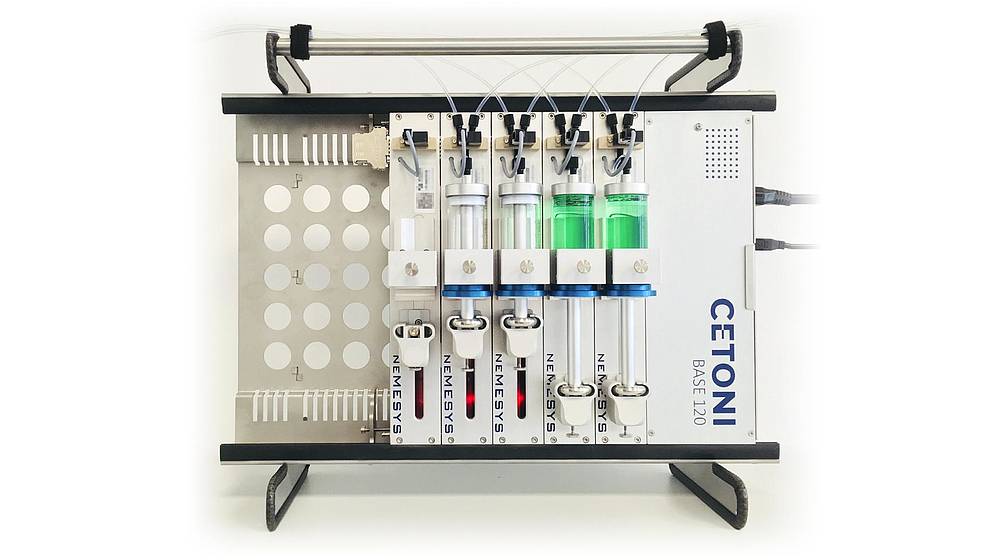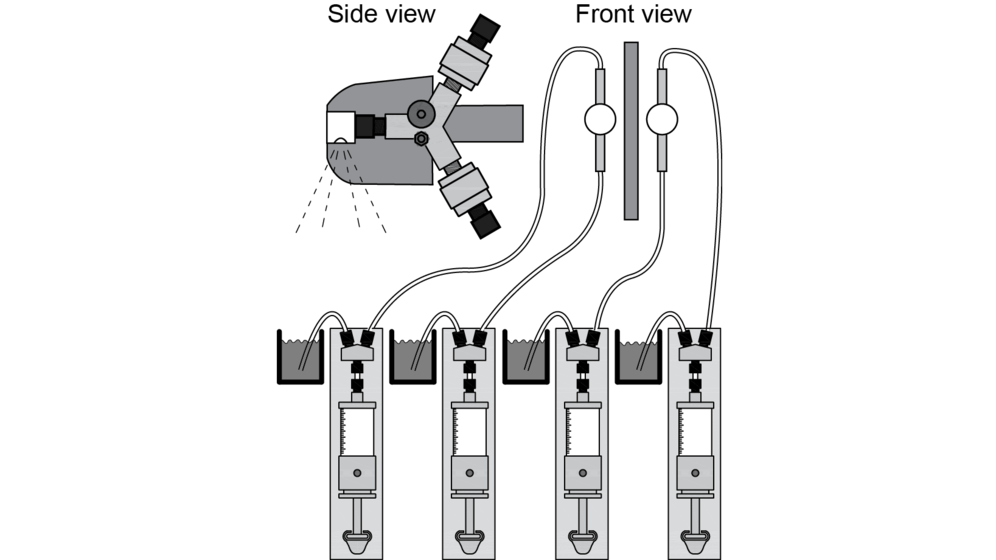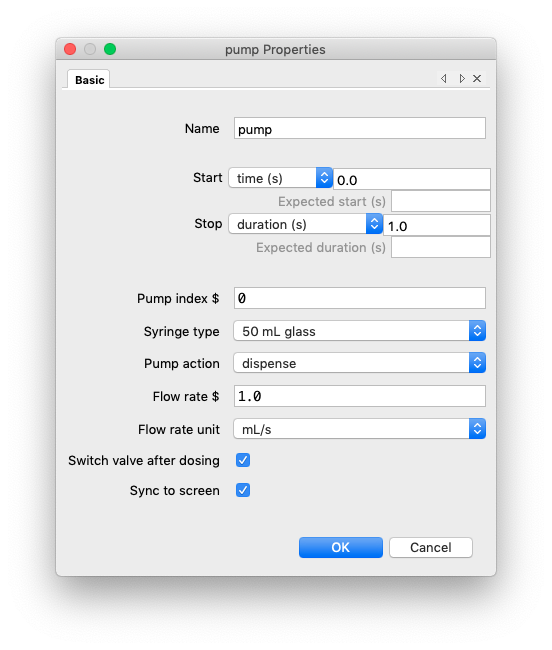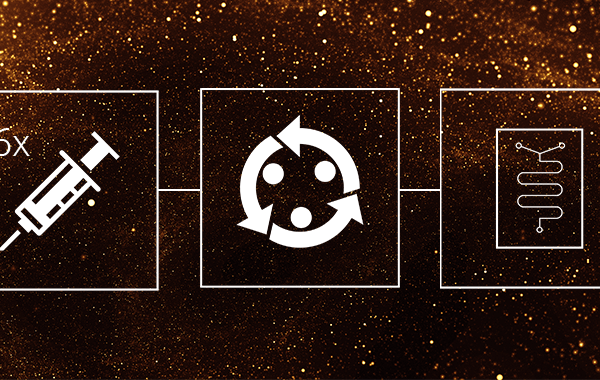A new versatile computer-controlled gustometer has recently been described Andersen et al. The device was built to match the specific needs of scientists running behavioral, electrophysiologal, and hemodynamic investigations.
 Hardware
Hardware
Laboratory Setup
The research group of Dr. Kathrin Ohla, hosted at the Institute of Neuroscience and Medicine 3 at Research Center Jülich, developed an affordable gustometer suitable for various experiments in taste research. The setup mainly consists of several low-pressure pumps neMESYS 290N for dosing of liquid taste solutions directly onto the participants’ tongues.
Andersen et al. employed a mouth piece that was mostly built from off-the-shelf components, allowing for an independent stimulation of the left and right side of the tongue (Fig. 3). In their particular investigation, de-ionized water was delivered to one or both sides of the tongue; 18 participants reported the perceived stimulation side. To test whether the stimulation system is suitable for electrophysiological investigations with a high temporal precision (in the milli-second range), some participants were repeatedly stimulated with a taste stimulus (sodium chloride solution) while brain activity was recorded using electroencephalography (EEG). Data analysis in fact revealed neural activation evoked by the taste stimulation. The flow rate was 1 ml/s, and automated dosing and refill cycles were enabled with the help of a computer-controlled 3/2 solenoid valve (3 connectors, 1/4”-28 UNF thread).

Image from: A new gustometer: Template for the construction of a portable and modular stimulator for taste and lingual touch (link) by Andersen et al. License: Creative Commons Attribution Non Commercial 4.0 International
A necessary requirement in the investigation was precise and pulsation-free stimulus delivery, combined with high reproducibility – key features of our neMESYS syringe pump technology. Further, the modularized setup is easy to extend and can be adjusted to meet new demands of future experiments; it also makes cleaning and replacement of individual components easy to comply with the high standards of hygiene, which is required in taste research.

Image from: A new gustometer: Template for the construction of a portable and modular stimulator for taste and lingual touch (link) by Andersen et al. License: Creative Commons Attribution Non Commercial 4.0 International
Software
The research team implemented a pump control interface in Python based on the CETONI Qmix Software Development Kit (SDK). This pyqmix package uses the Qmix SDK libraries (DLLs) and exposes the hardware interface via object-oriented Python code. The package was published under a free and open-source license and is available from GitHub. All interested users of our SDK may also use this Python package and adjust it to their needs. It is, therefore, a second option for using Python alongside CETONI’s official Python interface.
The following table provides a short comparison between both Python interfaces:
| CETONI Qmix SDK for Python | pyqmix | |
| C call interface | ctypes | cffi |
| Supported devices | Pumps Valves I/O Interfaces Controllers Motion Control Devices |
Pumps Valves |
| Installation | Zip Archive | Via pip (PyPI) or conda (conda-forge), contained in PsychoPy (standalone) |
| PsychoPy-Integration | no | yes |
| License | Modified BSD License | GPL 3.0 |
| GitHub Repository | https://github.com/CETONI-Software/qmixsdk-for-python | https://github.com/psyfood/pyqmix |
| Online documentation | QmixSDK_Python.html | https://pyqmix.readthedocs.io |
The following code snippet demonstrates how a pump can be operated via pyqmix:
from pyqmix import QmixBus, QmixPump, config
import time
# Specify the QmixELements configuration
config.set_qmix_config('qmix_config')
# Initialize the first pump
bus = QmixBus()
pump = QmixPump(index=0)
pump.set_flow_unit(prefix='milli', volume_unit='litres', time_unit='per_second')
pump.set_volume_unit(prefix='milli', unit='litres')
pump.set_syringe_params_by_type(syringe_type='50 ml glass')
# Fill the syringe
pump.generate_flow(-0.5, wait_until_done=True)
# Dispense 10x every 2 sec
for i in range(10):
pump.dispense(volume=1, flow_rate=1, wait_until_done=True, switch_valve_when_done=True)
time.sleep(2)
Andersen et al. also developed a remote control interface based on pyqmix, named pyqmix-web, allowing the user to control the pumps from within a web browser: Therefore, the user can control the gustometer via a graphical interface in the browser, i.e. remotely.
 This simple graphical interface also makes it possible to operate the pumps via a touchscreen, like an iPad or smartphone. Again, this software is provided under a free license and can be downloaded from the respective GitHub repository.
This simple graphical interface also makes it possible to operate the pumps via a touchscreen, like an iPad or smartphone. Again, this software is provided under a free license and can be downloaded from the respective GitHub repository.
Lastly, PsychoPy, a popular free and open-source software for conducting psychological and neuroscientific experiments, offers integration of pyqmix, thereby further simplifying the use of syringe pumps in neuroscientific studies:
 Summary
Summary
A compact, computer-controlled setup for precise and reproducible delivery of liquid taste stimuli has been developed. The system is suitable for electrophysiological investigations. The high precision of the neMESYS syringe pumps, combined with an elaborated setup, allowed the researchers to present taste stimuli with high precision and reproducibility. This versatile gustometer can be used to deliver multiple stimuli independently. Further, a Python (remote) control interface was developed based on the CETONI Software Development Kit (Qmix SDK), even allowing pump operation from a touchscreen-based device like an iPad or phone.
Used CETONI devices:
- Base Module BASE 120
- 5 x low-pressure syringe pumps neMESYS 290N
- Qmix SDK
Literature:
Andersen C., Alfine L., Ohla K., Höchenberger R.: A new gustometer: Template for the construction of a portable and modular stimulator for taste and lingual touch. Behavior Research Methods, 2018:1-15. DOI: 10.3758/s13428-018-1145-1



